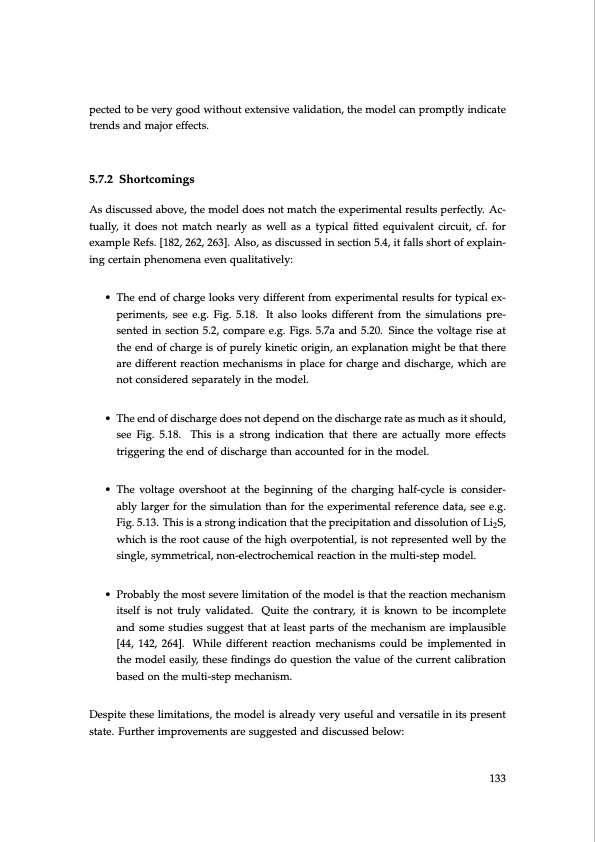
PDF Publication Title:
Text from PDF Page: 133
pected to be very good without extensive validation, the model can promptly indicate trends and major effects. 5.7.2 Shortcomings As discussed above, the model does not match the experimental results perfectly. Ac- tually, it does not match nearly as well as a typical fitted equivalent circuit, cf. for example Refs. [182, 262, 263]. Also, as discussed in section 5.4, it falls short of explain- ing certain phenomena even qualitatively: • The end of charge looks very different from experimental results for typical ex- periments, see e.g. Fig. 5.18. It also looks different from the simulations pre- sented in section 5.2, compare e.g. Figs. 5.7a and 5.20. Since the voltage rise at the end of charge is of purely kinetic origin, an explanation might be that there are different reaction mechanisms in place for charge and discharge, which are not considered separately in the model. • The end of discharge does not depend on the discharge rate as much as it should, see Fig. 5.18. This is a strong indication that there are actually more effects triggering the end of discharge than accounted for in the model. • The voltage overshoot at the beginning of the charging half-cycle is consider- ably larger for the simulation than for the experimental reference data, see e.g. Fig. 5.13. This is a strong indication that the precipitation and dissolution of Li2S, which is the root cause of the high overpotential, is not represented well by the single, symmetrical, non-electrochemical reaction in the multi-step model. • Probably the most severe limitation of the model is that the reaction mechanism itself is not truly validated. Quite the contrary, it is known to be incomplete and some studies suggest that at least parts of the mechanism are implausible [44, 142, 264]. While different reaction mechanisms could be implemented in the model easily, these findings do question the value of the current calibration based on the multi-step mechanism. Despite these limitations, the model is already very useful and versatile in its present state. Further improvements are suggested and discussed below: 133PDF Image | Lithium-Sulfur Battery: Design, Characterization, and Physically-based Modeling

PDF Search Title:
Lithium-Sulfur Battery: Design, Characterization, and Physically-based ModelingOriginal File Name Searched:
Dissertation_David_N._Fronczek_The_Lithium_Sulfur_Battery.pdfDIY PDF Search: Google It | Yahoo | Bing
Sulfur Deposition on Carbon Nanofibers using Supercritical CO2 Sulfur Deposition on Carbon Nanofibers using Supercritical CO2. Gamma sulfur also known as mother of pearl sulfur and nacreous sulfur... More Info
CO2 Organic Rankine Cycle Experimenter Platform The supercritical CO2 phase change system is both a heat pump and organic rankine cycle which can be used for those purposes and as a supercritical extractor for advanced subcritical and supercritical extraction technology. Uses include producing nanoparticles, precious metal CO2 extraction, lithium battery recycling, and other applications... More Info
| CONTACT TEL: 608-238-6001 Email: greg@infinityturbine.com | RSS | AMP |